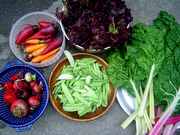

|
| Vegetable Varieties for Gardeners is a citizen science program
|
|
|
|
'Calliope' Eggplant |
| |
| Sub-Category: |
Early
|
| |
|
| Sub-Category 2: |
| | Description: |
Early Indian hybrid. Harvest at 2 inches for 'baby' 3 to 4 inches for mature fruit. Oval fuit with white and purple streaks, spineless calyxes.
|
| Days To Maturity: |
64
|
| Seed Sources: |
Thompson & Morgan US Seed Co. - updated in 2011
|
| |
| Rating Summary |
| |
Overall: (3.8 Stars)
Taste: (3.8 Stars)
Yield: (3.2 Stars)
Ease/Reliability: (3.6 Stars) |
| |
| Reviews |
| |
Login to share your Review of Calliope.
Number of Reviews: 5
KEY: O=Overall Rating, T=Taste, Y=Yield, E=Ease
Reviewed on 03/10/2009 by
GardenerHI
- An experienced gardener
|
 Overall Overall
 Taste Taste
 Yield Yield
 Ease Ease
|
Honolulu, Hawaii, United States
Frost Free Season: More than 203 days
Soil Texture: Sand
Garden Size: Small - Less than 400 square feet (20' x 20')
Sun Exposure: More than 8 hours per day
|
| Did not perform well in containers, nor in my hydroponics system. Also doesn't taste very good.
A much better choice for me which looks about the same as this one, and is also about the same size, is the heirloom "Udmalbet aka Udumalapet." |
| |
|
Reviewed on 07/07/2008 by
Green House
- An experienced gardener
|
 Overall Overall
 Taste Taste
 Yield Yield
 Ease Ease
|
Park, Montana, United States
Frost Free Season: 103 - 123 days
Soil Texture: Sand
Garden Size: Large - More than 1,600 square feet (40' x 40')
Sun Exposure: 6 to 8 hours per day
|
| I grow the Calliope at the South Pole Food Growth Chamber. It does very well in the hydroponics system.
T.Eddington
We only use Johnny Seeds! |
| |
|
Reviewed on 06/18/2008 by
containergardener
- An experienced gardener
|
 Overall Overall
 Taste Taste
 Yield Yield
 Ease Ease
|
Los Angeles, California, United States
Frost Free Season: More than 203 days
Soil Texture: Sand
Garden Size: Medium - 400 square feet to 1,600 square feet
Sun Exposure: More than 8 hours per day
|
| Calliope grew very well in a 5-gallon black plastic container. It is an attractive plant and it produced well. We picked the fruit at 3 to 4 inches in length and it was a very good sweet eggplant. It started up again the next spring. While the second-season plant was decorative, the fruit was no longer good. (In southern California, peppers, eggplant and, to a lesser extent, cherry tomatoes perennialize.) |
| |
|
Reviewed on 12/17/2007 by
DrFood
- An experienced gardener
|
 Overall Overall
 Taste Taste
 Yield Yield
 Ease Ease
|
Dane, Wisconsin, United States
Frost Free Season: 123 - 143 days
Soil Texture: Loam
Garden Size: Medium - 400 square feet to 1,600 square feet
Sun Exposure: More than 8 hours per day
|
| I've grown this variety for three years now in my Wisconsin garden--I love it. The plants are bushy and beautiful with purple flowers and lots of small striped fruits. Don't let them get yellow! (Although if you do, you can still roast them and make baba ganouj.)
They do great in my raised beds, growing in extremely high quality soil. I don't do any spraying, and although they get munched a little by flea beetles it doesn't seem to slow them down. Last summer I put an extra seedling back in the pumpkin patch, with poorer soil and probably less watering, and it didn't do as well.
My only problem is that my husband doesn't like eggplant. Two plants make more than I can eat! The fruits are so adorable, though, they're pretty easy to give away. |
| |
|
Reviewed on 10/28/2005 by
Sahale
- An experienced gardener
|
 Overall Overall
 Taste Taste
 Yield Yield
 Ease Ease
|
Seneca, New York, United States
Frost Free Season: 163 - 183 days
Soil Texture: Clay
Garden Size: Medium - 400 square feet to 1,600 square feet
Sun Exposure: More than 8 hours per day
|
| These eggplants look great on the plant, and are a more convenient size than standard eggplant. The productivity is good, but less than the bounty of standards. Tasted ike eggplant--are there subtle differences in eggplant flavor? It was a little tricky to tell when they were ripe. Some, but not all over-ripe fruit get yellow. Flea beetles found them very attractive, requiring repeated treatment. I'll try them again. |
| |
|
|
|
|
Vegetable Varieties for Gardeners is a citizen science program, © 2004-2025, All Rights Reserved
Cornell Garden Based Learning, Cornell University College of Agriculture & Life Sciences, Horticulture Section
|






 VVfG home
VVfG home
 Overall
Overall Yield
Yield Overall
Overall Overall
Overall